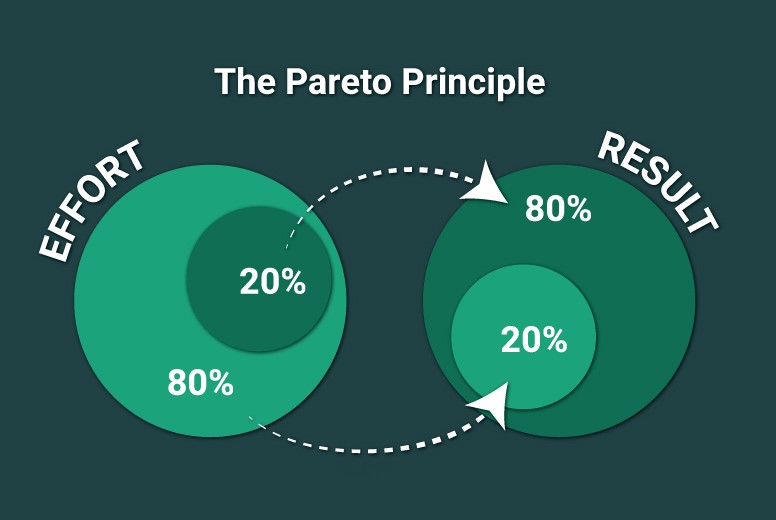
An Overview of the Pareto Principle (80/20 Rule)
The Pareto Principle, also known as the 80/20 rule, is a concept that suggests 80% of outcomes often result from 20% of efforts. This principle was first introduced by Italian economist Vilfredo Pareto in 1896 when he observed that 80% of Italy’s wealth was owned by 20% of the population. Over time, this idea has been widely applied across various fields, including business, economics, and time management.
In business, 80/20 Rule helps companies identify the key areas that contribute the most to their success. For example, it is common to find that 80% of a company’s revenue comes from 20% of its customers or that 20% of products generate 80% of sales. By recognizing these vital factors, businesses can focus resources more efficiently, improving productivity and profitability.
The Pareto Principle is also highly useful in personal productivity and time management. Individuals can use the rule to prioritize tasks that produce the most significant results. Instead of trying to tackle every task equally, the 80/20 rule encourages focusing on the 20% of activities that yield 80% of desired outcomes. Whether applied in business or personal life, The Pareto Principle helps people and organizations achieve more with less effort by concentrating on what truly matters.
Applications of the Pareto Principle in Business
The Pareto Principle offers businesses a powerful tool to improve productivity and decision-making by focusing on the most impactful areas. In sales, companies often find that 80% of their revenue comes from just 20% of their customers or products. By identifying these high-value customers or top-selling products, businesses can allocate more resources to nurture those relationships and increase profits. This targeted approach helps businesses maximize their efforts while reducing wasted time and energy on less productive areas.
In terms of productivity, the 80/20 rule encourages businesses to focus on the 20% of tasks or processes that contribute most to their success. For example, companies can streamline operations by identifying key processes that drive efficiency, then investing in automation or improved workflows for those activities. This focus allows teams to prioritize high-impact tasks, leading to faster project completion and improved overall output. By applying The Pareto Principle to time management, businesses can significantly enhance employee productivity and ensure that resources are used more effectively.
Decision-making can also benefit from The Pareto Principle by helping leaders focus on the most critical data and insights that drive strategic decisions. Instead of analyzing every available metric, companies can identify the most relevant data points that contribute to business growth. This focused approach leads to faster, more informed decisions, giving businesses a competitive edge. Applying The Pareto Principle allows companies to cut through distractions and focus on the key elements that truly drive success.
Time Management and Efficiency with the 80/20 Rule
The Pareto Principle, also known as the 80/20 rule, is a powerful tool for optimizing time management and boosting efficiency. It suggests that 80% of results come from 20% of efforts. By applying this principle, individuals and teams can prioritize high-impact tasks and focus their energy on what truly matters. Instead of attempting to complete every task equally, the Pareto Principle encourages identifying the key activities that deliver the most significant results.
For individuals, this approach can be transformative in managing daily tasks. By recognizing the 20% of activities that contribute most to professional goals, individuals can focus their efforts and avoid wasting time on less important tasks. For example, instead of spending excessive time on administrative tasks, prioritizing strategic work can yield far better outcomes. This targeted focus allows for more effective use of time and greater personal productivity.
Teams can also benefit by using The Pareto Principle to streamline processes and improve efficiency. By identifying the core 20% of projects or initiatives that drive the most value, teams can align their efforts to ensure maximum impact. This focus helps eliminate distractions and ensures that resources are concentrated on the highest-priority work. When both individuals and teams apply The Pareto Principle, they can significantly enhance their performance and achieve better results with less effort.
Improving Customer Relationships and Sales Using the Pareto Principle
The Pareto Principle, or the 80/20 rule, is highly effective in improving customer relationships and boosting sales. By recognizing that 80% of a company’s revenue often comes from just 20% of its customers or products, businesses can focus their efforts on the areas that generate the greatest return. Identifying these high-value customers or top-performing products allows companies to allocate resources more strategically and maximize profitability.
In practice, businesses can apply The Pareto Principle by analyzing their sales data to pinpoint the customers who contribute the most to their bottom line. Once identified, companies can enhance their relationship with these customers through personalized communication, targeted offers, and dedicated support. By deepening these relationships, businesses can increase customer loyalty, drive repeat business, and encourage referrals. These all contribute to higher sales over time.
Similarly, focusing on the 20% of products or services that generate 80% of sales allows companies to streamline their product lines and invest in the most profitable offerings. This approach can lead to better inventory management, improved marketing strategies, and more focused sales efforts. By using The Pareto Principle to direct resources toward the most valuable customers and products, businesses can enhance efficiency. This ensures that their efforts yield the highest possible returns.
Limitations and Misconceptions of the Pareto Principle
While The Pareto Principle is a useful tool, it comes with limitations and common misconceptions. One frequent misunderstanding is the assumption that the 80/20 ratio is always exact. In reality, the distribution can vary depending on the context. The 80/20 rule serves as a guideline rather than a strict mathematical formula. The actual ratio may differ significantly in certain situations. Businesses should avoid rigidly applying the rule without considering their specific data.
Another limitation of The Pareto Principle is that it may oversimplify complex systems. Focusing solely on 20% of activities or customers may overlook critical factors that also contribute to overall success. For instance, while high-value customers are essential, neglecting smaller customers or less profitable products could harm long-term growth and market share. This principle, while powerful, must be balanced with a holistic view of the business.
Additionally, The Pareto Principle does not always account for changing circumstances. Markets evolve, and what constitutes the top 20% today may shift tomorrow. Businesses should regularly reassess which activities or customers drive the most value and adjust their strategies accordingly. By recognizing these limitations and misconceptions, companies can apply The Pareto Principle more effectively while avoiding potential pitfalls. This ensures a more balanced and strategic approach in complex business environments.
Conclusion
In conclusion, The Pareto Principle offers valuable insights into maximizing efficiency by focusing on the most impactful areas of a business. Whether applied to customer relationships, sales, or time management, the 80/20 rule helps businesses allocate resources more effectively. However, it is essential to understand the principle’s limitations and avoid overgeneralizing its application. By regularly reassessing which efforts yield the most significant results, businesses can adapt to changing conditions and continue to thrive. When used thoughtfully, The Pareto Principle remains a powerful tool for driving success and improving overall performance.


